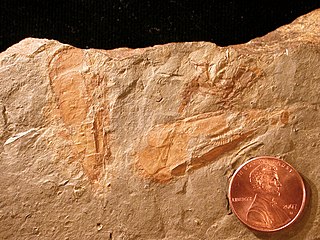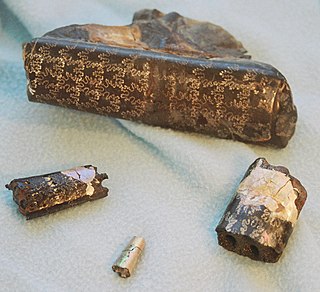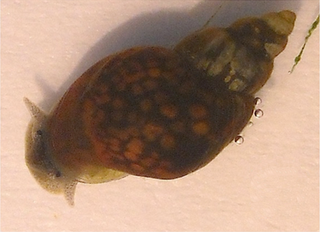
A shotgun is a long-barreled firearm designed to shoot a straight-walled cartridge known as a shotshell, which discharges numerous small spherical projectiles called shot, or a single solid projectile called a slug. Shotguns are most commonly used as smoothbore firearms, meaning that their gun barrels have no rifling on the inner wall, but rifled barrels for shooting sabot slugs are also available.

Hyoliths are animals with small conical shells, known from fossils from the Palaeozoic era. They are at least considered as being lophotrochozoan, and possibly being lophophorates, a group which includes the brachiopods, while others consider them as being basal lophotrochozoans, or even molluscs.

Ammonoids are extinct spiral shelled cephalopods comprising the subclass Ammonoidea. They are more closely related to living coleoids than they are to shelled nautiloids. The earliest ammonoids appeared during the Devonian, with the last species vanishing during or soon after the Cretaceous–Paleogene extinction event. They are often called ammonites, which is most frequently used for members of the order Ammonitida, the only living group of ammonoids from the Jurassic up until their extinction.

The siphuncle is a strand of tissue passing longitudinally through the shell of a cephalopod mollusk. Only cephalopods with chambered shells have siphuncles, such as the extinct ammonites and belemnites, and the living nautiluses, cuttlefish, and Spirula. In the case of the cuttlefish, the siphuncle is indistinct and connects all the small chambers of that animal's highly modified shell; in the other cephalopods it is thread-like and passes through small openings in the septa (walls) dividing the camerae (chambers). Some older studies have used the term siphon for the siphuncle, though this naming convention is uncommon in modern studies to prevent confusion with a mollusc organ of the same name.

Closer to Heaven is a musical by Jonathan Harvey and Pet Shop Boys. It was premiered in May 2001 at the Arts Theatre in London, opening to mixed reviews, and ran until 13 October 2001. A second production of Closer to Heaven was premiered in Australia in 2005. New off-West End productions premiered in London in 2015, 2019 and 2024.

Nautiloids are a group of marine cephalopods (Mollusca) which originated in the Late Cambrian and are represented today by the living Nautilus and Allonautilus. Fossil nautiloids are diverse and species rich, with over 2,500 recorded species. They flourished during the early Paleozoic era, when they constituted the main predatory animals. Early in their evolution, nautiloids developed an extraordinary diversity of shell shapes, including coiled morphologies and giant straight-shelled forms (orthocones). No orthoconic and only a handful of coiled species, the nautiluses, survive to the present day.
Pump action is a type of manual firearm action that is operated by moving a sliding handguard on the gun's forestock. When shooting, the sliding forend is pulled rearward to eject any expended cartridge and typically to cock the hammer or striker, and then pushed forward to load a new cartridge into the chamber. Most pump-action firearms use an integral tubular magazine, although some do use detachable box magazines. Pump-action firearms are typically associated with shotguns, although it has also been used in rifles, grenade launchers, and other types of firearms. A firearm using this operating mechanism is colloquially referred to as a pumpgun.

Baculites is an extinct genus of heteromorph ammonite cephalopods with almost straight shells. The genus, which lived worldwide throughout most of the Late Cretaceous, and which briefly survived the K-Pg mass extinction event, was named by Lamarck in 1799.

Field artillery in the American Civil War refers to the artillery weapons, equipment, and practices used by the Artillery branch to support the infantry and cavalry forces in the field. It does not include siege artillery, use of artillery in fixed fortifications, or coastal or naval artillery. Nor does it include smaller, specialized artillery classified as small arms.

Stanislas Wawrinka is a Swiss professional tennis player. He reached a career-high Association of Tennis Professionals (ATP) singles ranking of world No. 3 on 27 January 2014. He is a three-time Grand Slam champion, at the 2014 Australian Open, the 2015 French Open and at the 2016 US Open, where he defeated the world No. 1 player in the final on all three occasions.

Closer to Heaven is an album of songs from the Pet Shop Boys 2001 stage musical Closer to Heaven. The songs feature the original London production cast and production credits go to Pet Shop Boys and Stephen Hague.

The razor shell, Ensis magnus, also called razor clam, razor fish or spoot (colloquially), is a bivalve of the family Pharidae. It is found on sandy beaches in Canada and northern Europe.
The 1991 Ginebra San Miguel season was the 13th season of the franchise in the Philippine Basketball Association (PBA).
The 1992 San Miguel Beermen season was the 18th season of the franchise in the Philippine Basketball Association (PBA).
The 1996 Ginebra San Miguel season was the 18th season of the franchise in the Philippine Basketball Association (PBA).
Reedsoceras is a genus of large discosorids (Nautiloidea) in the family Westonoceratidae from the middle and upper Ordovician of North America.

Eutrephoceras is an extinct genus of nautilus from the Late Jurassic to the Miocene. They are characterized by a highly rounded involute shell with slightly sinuous suture patterns.

Galba schirazensis is a species of air-breathing freshwater snail, an aquatic pulmonate gastropod mollusk in the family Lymnaeidae, the pond snails.
TeamGym is a form of competition created by the European Union of Gymnastics. The first official competition was held in Finland in 1996. Originally named EuroTeam, TeamGym received its current name in 2002. From 1996 to 2008, the European Championships was an event for clubs; since 2010 the competition is contested with national teams representing different countries. TeamGym events consist of three sections: women, men and mixed teams. Gymnasts perform skills in three different disciplines: floor, tumbling and trampette. In common for the performance is effective teamwork, good technique in the elements and spectacular acrobatic skills.












